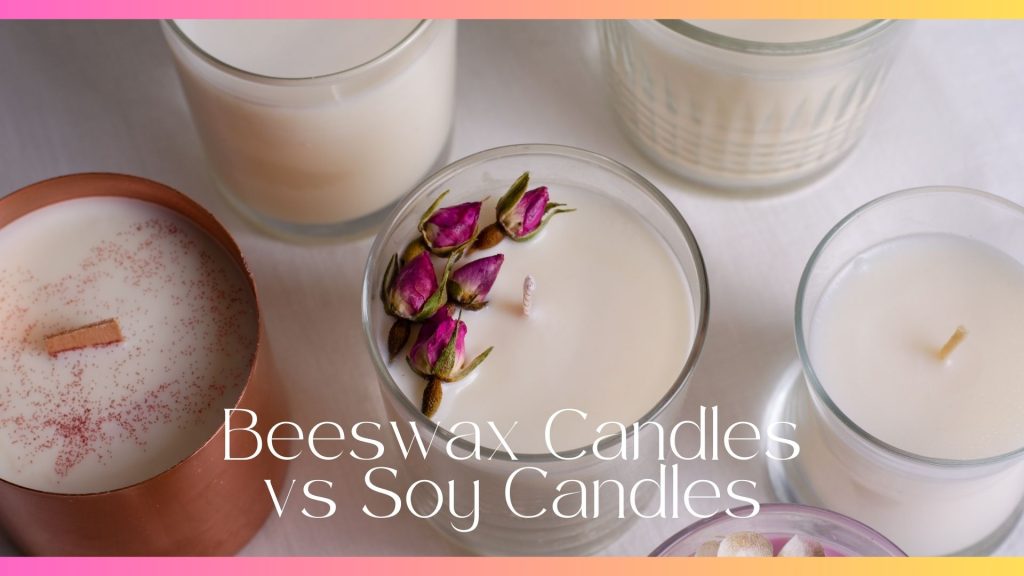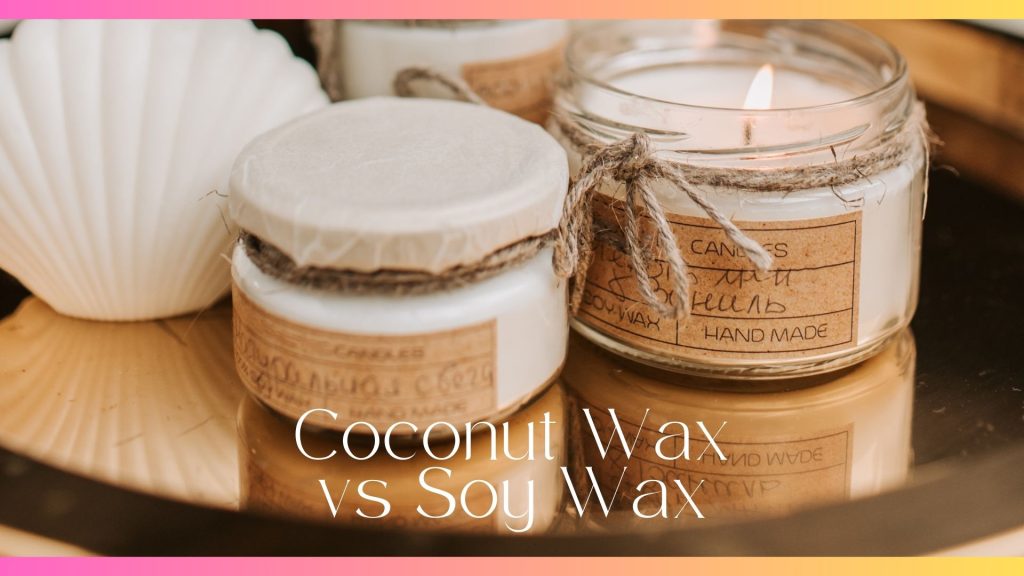Looking for an easy coconut wax candle recipe for you to follow? Here’s everything you need to get started with your candle-making journey.
Making coconut wax candles is just as simple as making soy candles. However, there are some differences you should know – especially when it comes to the right temperatures to work with.
In this article, I’ll share more on how you can start making your own coconut wax candles and the basic materials you’ll need.
Disclaimer: This post may contain affiliate links. This means I may earn a small commission (at no cost to you) if you sign up for a program or make a purchase using my link!
Related Posts:
- Soy Candles vs Coconut Candles for Candle-making
- How To Make Coconut Wax Candles with Essential Oils
- How To Compare Coconut Wax to Beeswax for Candle-making
Why Choose Coconut Wax for Candle Making?
There are various reasons why one would prefer coconut wax over other kinds of waxes like soy or paraffin.
Coconut wax that’s made from the coconut fruit is not only eco-friendly by also sustainable and biodegradable. With that said, they burn cleanly and lasts longer than other types of waxes when made into candles.
Candle-makers also prefer to use them or coconut wax blends for candle-making as they are easy to work with and have a strong scent throw compared to soy.
Easy Coconut Wax Candle Recipe
Looking for an easy coconut wax candle recipe? It doesn’t have to be complicated!
Generally, 3.5oz of wax flakes (or 100gm) should be enough to fill a 100ml container when melted, leaving some room at the top for the wick. Just multiply to get the amount you’ll need for the number of candles you’re making, based on the container size you’re using.
Here’s one to guide you for your next project.
Ingredients You’ll Need
- 100% pure coconut wax: Choose high-quality coconut wax in the form of flakes as they’re easy to work with.
- Cotton candle wicks: Select cotton wicks appropriate for the diameter of your candle containers with a suitable wick sticker.
- Glass containers: You’ll need heat-resistant containers like glass jars, tins, or ceramic pots. Choose one that is stable and avoid ones that has a bigger bottom than the top to prevent candle tunneling.
- Fragrance Oils (Optional): Choose high-quality, phthalate-free fragrance oils to create scented candles.
- Colorants (Optional): Use candle-safe dyes and do not use crayons or food coloring, as they can clog the wick and affect the burn quality.
Tools You’ll Need
- Digital scale: To measure the wax and fragrance oils for exact amount.
- Metal spoon: Used to stir the wax and fragrance oils for a balanced blend.
- Candle pitcher: Metal jug to hold wax while it melts using double boiling method and for pouring.
- Digital thermometer: To monitor temperature of the wax.
- Wick holder: To keep your wicks in placed when cooling.
- Gloves and goggles: Always prioritize safety while making your candles.
Step-by-Step Guide
- Prepare your work station: Set up a flat workspace and layer with newspaper or a silicone mat to keep things neat from spilled waxes. Arrange your materials and tools for easy reach.
- Measure the coconut wax: Measure the amount of coconut wax needed using a digital scale – 3.5oz of wax should be enough to fill a 100ml container.
- Melt the wax: Melt the wax in a double boiler or a heat-safe bowl over a pot of simmering water.
- Clean your containers: While the wax is melting, prepare your containers by cleaning it with a dry kitchen towel.
- Prepare the candle wicks: Attach the wicks to the bottom of each container using a wick sticker.
- Add fragrance oils and color dye: Once the wax is fully melted, remove it from the heat and let it cool slightly before adding any fragrance oils and colorants. Stir gently to mix it well without causing air bubbles.
- Pour the wax into containers: Carefully pour the melted wax into your prepared containers. Leave a little space at the top of each container for the wick.
- Keep your wick in place: Use a wick holder or something to keep the wick upright in the center.
- Set the candles aside: Allow the candles to cool for a few hours until solidified and avoid moving them.
- Trim the wicks: Once set, trim the wicks to about 1/4 inch and store in cool dry place away from sunlight.
Tips for Perfect Coconut Wax Candles
For the best results, you’ll have to ensure that your wick is properly placed in the center of the jar. Aside from making sure it looks good, it’s important so that the candle burns evenly on all sides.
Of course, you will have to choose a wick size that is suitable for the size of the jar. This ensures an even burn and also prevents candle tunneling.
Tunneling happens when the wax on the sides are not melted causing a vertical looking tunnel. You’ll have to burn the candle long enough so the entire top surface of the wax is melted during each use.
First time candle-makers may also face issues of air bubbles or wet spots when the wax has cooled in the jar. This can be avoided by pouring the wax at a cooler temperature and at a steady rate (slowly). If you notice any bubbles, gently tap the container on the counter to release them.
Similarly, sink holes can occur when the wax cools to quickly. If this happens, just create a few holes on the surface and use a heat gun to melt the wax at the top so it fills the gaps.
Coconut Wax Candle Recipe with Essential Oils
Compared to fragrance oils, essential oils are made of natural ingredients and are usually more concentrated. Not all are suitable for candle-making so you’ll have to follow the manufacturer’s guidelines if it’s okay to use.
As they are more concentrated, you probably need lesser amount when using them in your candles compared to the usual fragrance load ratio of 6-10%. Too much of it may also make your candles flammable – not supposed to be.
If your essential oils can be used for candle-making, just add them to the melted wax according to the steps I’ve listed above at a suitable amount. Since all products are not the same, it’s best that you test your candles using different amounts of essential oils to see what works.
Bottom Line
Making coconut wax candles doesn’t have to be difficult if you have all the materials ready. Just follow the steps above carefully if it’s your first time and always put your safety first.
With enough practice, you’ll make excellent candles and won’t need a recipe to begin with!
Frequently Asked Questions (FAQs)
Coconut wax is generally considered healthy for candles. It is made from the oil extracted from coconuts and is known for its clean-burning properties. Coconut wax produces less soot compared to paraffin wax, reducing indoor air pollution. It is also biodegradable and does not release harmful chemicals when burned. However, to ensure a healthier candle, it’s important to use high-quality, pure coconut wax and avoid synthetic additives. Additionally, using natural wicks and essential oils can further enhance the healthiness of your candles.
The ratio of coconut oil to wax in candle making typically ranges from 10-20% coconut oil to 80-90% wax. This blend helps to adjust the texture and burning quality of the candle. For example, if you are using 1 pound of wax, you might add 4 to 8 ounces of coconut oil. The coconut oil softens the wax, enhancing the candle’s fragrance throw and making it easier to pour, while the wax maintains the candle’s structure and burning time.
Manufacturing coconut wax involves several key steps. First, coconuts are harvested, and the oil is extracted from the coconut meat. This oil is then refined to remove impurities. The refined oil is subjected to a process called hydrogenation, where it is mixed with hydrogen gas under high pressure and temperature to solidify the oil into wax. The resulting coconut wax is then filtered and cooled, ready to be used for candle making. This process ensures that the wax has a smooth texture and consistent burning properties.
Whether coconut wax is better than beeswax for candles depends on your specific needs. Coconut wax is known for its clean-burning properties, smooth texture, and excellent scent throw. It is also more affordable and easier to work with compared to beeswax. However, beeswax has a natural honey scent, purifies the air by releasing negative ions, and has a longer burn time. Beeswax is also more sustainable if sourced from responsible beekeepers. For a high-quality candle, many crafters use a blend of both to combine their benefits.


